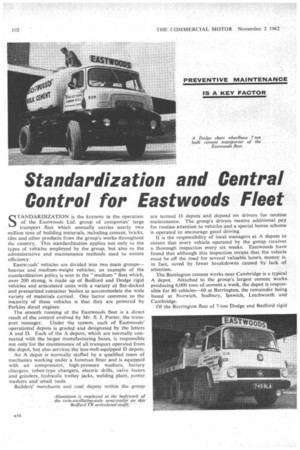Standardization and Central Control for Eastwoods Fleet
Page 104

Page 105

If you've noticed an error in this article please click here to report it so we can fix it.
STANDARDIZATION is the keynote in the operation of the Eastwoods Ltd. group of companies' large transport fleet which annually carries nearly two million tons of building materials, including cement, bricks, tiles and other products from the group's works throughout the country. This standardization applies not only to the types of vehicles employed by the group, but also to the administrative and maintenance methods used to ensure efficiency.
Eastwoods' vehicles are divided into two main groups— heavies and medium-weight vehicles; an example of the standardization policy is seen in the "medium " fleet which, over 200 strong, is made up of Bedford and Dodge rigid vehicles and articulated units with a variety of flat-decked and pressurized container bodies to accommodate the wide variety of materials carried. One factor common to the majority of these vehicles is that they are powered by Perkins diesel engines.
The smooth running of the Eastwoods fleet is a direct result of The control evolved by Mr. S. I. Porter, the transport manager. Under the system, each of Eastwoods' operational depots is graded and designated by the letters A and D. Each of the A depots, which are normally connected with the larger manufacturing bases, is responsible not only for the maintenance of all transport operated from the depot, but also services the' less-well-equipped D depots.
An A depot is normally staffed by a qualified team of mechanics working under a foreman fitter and is equipped with air compressors, high-pressure washers, battery chargers, robot-type changers, electric drills, valve facers and grinders, hydraulic trolley jacks, welding plant, power.
washers and small tools. .
Builders' merchants and coal depots within the group are termed D depots and depend on drivers for routine maintenance. The group's drivers receive additional pay fen routine attention to vehicles and a special bonus scheme is operated to encourage good driving. It is the responsibility of local managers at A depots to ensure that every vehicle operated by the group receives a thorough inspection every six weeks. Eastwoods have found that although this inspection means that the vehicle must be off the road for several valuable hours, money is, in fact, saved by fewer breakdowns caused by lack of attention.
The Barrington cement works near Cambridge is a typical A depot. Attached to the group's largest cement works, producing 6,000 tons of cement a week, the depot is responsible for 80 vehicles-60 at Barrington, the remainder being based at Norwich, Sudbury, Ipswich, Letchworth and Cambridge.
Of the Barrington fleet of 7-ton Dodge and Bedford rigid and articulated bulk transporters and flat loaders, 34 are fitted with Perkins diesels. Pulling loads up to 12 tons, the 6.354-powered units are said to be returning between 9 and 10 m.p.g. Normal rigid-bodied Bedfords carrying 8 ton loads return up to 17 m.p.g. when fitted with the 112 b.h.p. Perkins.
Vehicles based at Barrington average up to 900 miles a week on journeys throughout East Anglia. They are maintained by six fitters and two apprentices, led by the depot foreman; The A depot at South Ferriby is attached to a smaller cement works on the banks of the Humber, responsible for deliveries within a 70-mile radius. The local transport manager is responsible for a total of 44 vehicles.
Transport also plays a very important part in the production and distribution of Eastwoods' other main product —bricks. The group makes two types of brick—Flettons, produced at three works near Peterborough and Bedford, and London Stocks, at six plants in Kent, Essex and Hampshire.
The amount of transport operated from Kempston Hardwick, near Bedford, and the closely allied Peterborough works at Orton and Yaxley, warrants them both being A depots.
There is a 40 vehicle fleet at Kempston Hardwick, and a total of 32 lorries are based at Peterborough, where maintenance is also carried out on vehicles from Coventry and King's Lynn.
The continuous manufacturing processes at the Fletton brick works mean that the Hyster 8,000 lb fork-lift trucks work 100 hour weeks, setting the " green " bricks into kilns and removing them after their 14 day firing. At Kempston Hardwick this involves the handling of no less than 21 million tons of bricks each week and only a quarter million tons less at Peterborough.
Just as Eastwoods' Fletton works are situated on the narrow belt of Oxfordshire blue clay which runs from Lincolnshire to the Salisbury Plain, so the group's stockbrick works are mostly centred around the lower reaches of the Thames—the location of the brick earth which constitutes 65 per cent of the bricks from which the greater part of London was built. The group is actually the largest producer of stock bricks in the country. The Eastwoods stock-brick works' close proximity to London also provides a ready supply of the bricks' second largest ingredient— ashes, which are reclaimed from domestic and industrial refuse.
The only A depot within Eastwoods' stock-bricks division is based at Halstow, near the Medway towns in Kent, which looks after 50 vehicles based south of the Thames.
































































































































































